Hadestown's "Chant" is Peak Theater Staging
So, for the past few weeks I’ve had musical brainrot. It’s the combination of my family going to New York for Christmas and seeing Hadestown (second time for me, first for the rest of my family) and me watching the Wicked movie when it got released on digital. I’m a huge fan of musicals and Broadway so those weeks have sort of been a fever dream. I am still amazed how good the Wicked movie turned out. Broadway-to-movie adaptations are generally pretty terrible and when I heard they were going to split Wicked into two parts, I was really concerned. But the jokes on me because that was a phenomenal decision. I still get goosebumps watching that final part of Defying Gravity; my soul literally ascended. It was already such an iconic moment on the stage, and they translated it so well for the screen.
That did get me thinking, though, about Hadestown and what an adaptation would be like. Hadestown is my favorite musical and honestly, probably my favorite work of art period. I am really hoping a pro-shot of the musical gets released at some point, but when it comes to a film adaptation, that gives me pause. A big component of what makes the show work is the staging. Rachel Chavkin, the director, did such a good job of having the staging perfectly use the medium of theater to convey the story. It uses so many unique aspects of the stage that I feel would be very difficult to replicate on the screen. You really do have to see it live to experience it.
A sequence that I think exemplifies this would be the “Chant” sequence, which happens roughly midway through the first act. So, I guess this is a spoiler warning before I continue. It’s not that much of a spoiler since it happens relatively early, but I will be explaining the story up to and including the “Chant” sequence to be able to fully explain how the staging enhances how the story there is conveyed.
Background Context for “Chant”
Basically, Hadestown is set in a very vague Depression-era, steampunk-esque setting. The weather is really harsh, oscillating between burning summers and harsh winters. Hades had just arrived to take Persephone back to Hadestown meaning winter is coming. Orpheus believes he can write a song to make spring return again, so he is focusing on that while Eurydice, whom they just got together, is trying to find food and shelter for them to survive.
During the “Chant” sequence, the focus switches between two points. The first is with Hades and Persephone in Hadestown, which is basically the underworld if it was a factory town. Here Persephone expresses her loathing for Hadestown and the industrialization Hades has done while Hades claps back that everything he has done was for her. It’s a really good showcase of how their relationship is deteriorating.
The second focus is on the folks above like Orpheus, who is super focused on completing the song, and Eurydice, who has to pick up the slack for Orpheus being too focused to help them survive. Orpheus eventually figures out the seasons are wack because “the gods have forgotten the song of their love”, but he’s so focused on the song that he’s unaware the Eurydice is suffering and having an all around really bad time trying to get them food and shelter, eventually being caught in the storm.
You can see here immediately that there is some nice parallelism going on with how both relationships are deteriorating, Hades and Persephone’s having been through it for much longer but still. This of course will lead to Hades offering Eurydice a ticket to Hadestown, which Eurydice, out of desperation, accepts.
During the sequence, which switches back and forth between the two focuses, this parallelism is highlighted. We set the stage for future events and show the conflicts the characters are facing. So how does the staging help enhance how this story is conveyed?
The Staging for “Chant”
Now unfortunately, there isn’t a lot of official footage for this sequence, so I’m going to have to rely on a certain “slime tutorial” that I found in London. If you haven’t seen the sequence, I do recommend seeing it before I delve into it. Don’t tell anyone but I heard through the grapevine you can find it here.
The Setup
Anyways, “Chant” follows from “Epic II” where Orpheus begins to work on his song. The transition has Hades and Persephone rise from below the stage to above on a platform in the middle of the turntable, and the Hadestown workers are in a circle surrounding them. Basically, the setup has Hades and Persephone on that risen center platform as representing Hadestown, while the outer ring represents the world above, with the workers in the in-between ring providing a physical separation of the two “realms”. The triple turntable also helps with this separation as each segment is rotating in the opposite direction of the ones adjacent to it. And finally, whenever the song focuses on either Hadestown or the world above, the lights switch between red/orange (representing the hellishly hot Hadestown) and blue (representing the overworld buffeted by the harsh winter).
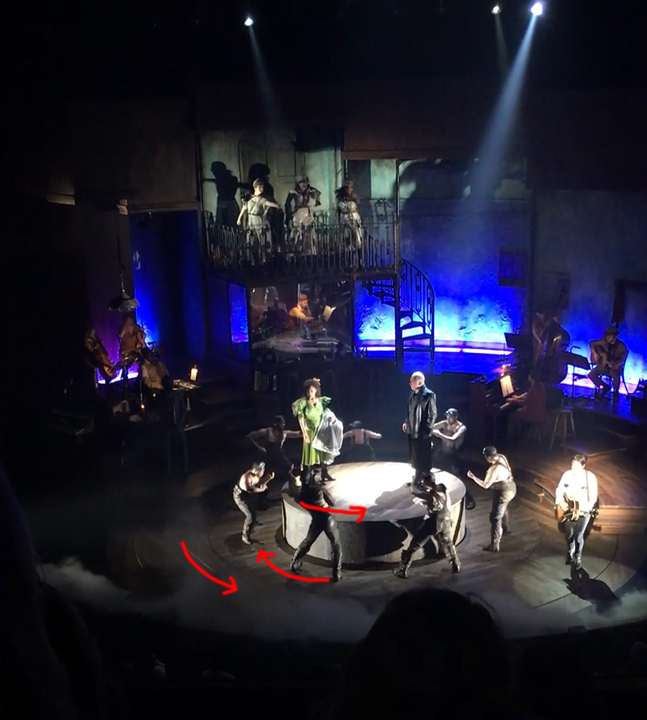
Overall stage setup. Arrows represent the initial rotation direction.
Now why is this setup so important? First of all, all of those elements in the separation allows the audience to understand that those are two different settings. Through the staging alone we know when we are focusing in Hadestown and when we are focusing in the overworld, without needing any scene changes. This allows the quick back and forth switching of focuses in the song, which is really important. The audience can use their imagination to fill in the gaps and we fundamentally understand and accept that what is happening between the center and outer ring of the turntable are two different locations.
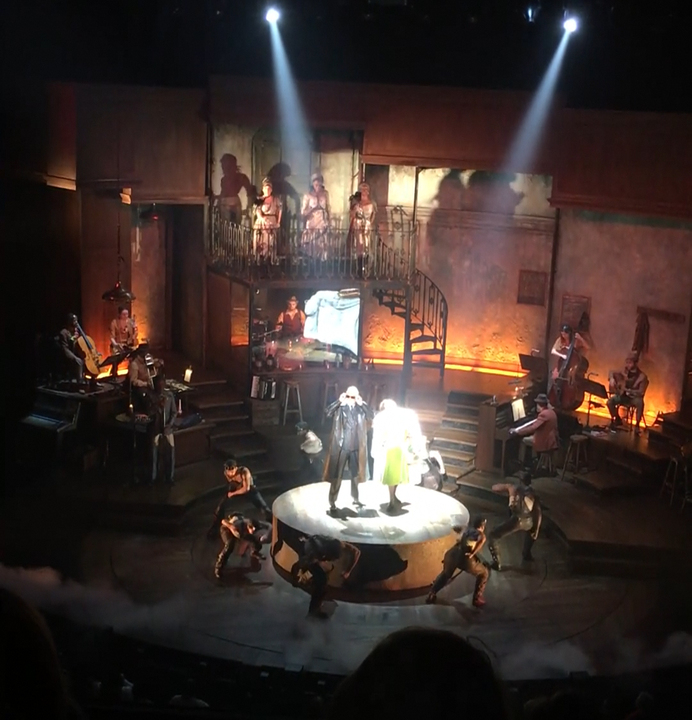
The lighting when focusing on Hadestown.
In addition, even though the characters are in two different “realms”, through this staging they are still connected as physically they are literally on the same stage. It shows it is still part of one world and actions and consequences of them are interwoven. And on this point, it allows the actors to lightly “interact” with the other side. There is a scene where Persephone laments how people “are starving up above” and the actress can literally point to Eurydice (who is on stage in the outer ring and had just lost her things to the wind). Even though “in-universe” Persephone and Eurydice are way apart, through this medium of the stage we can have this “interaction”.
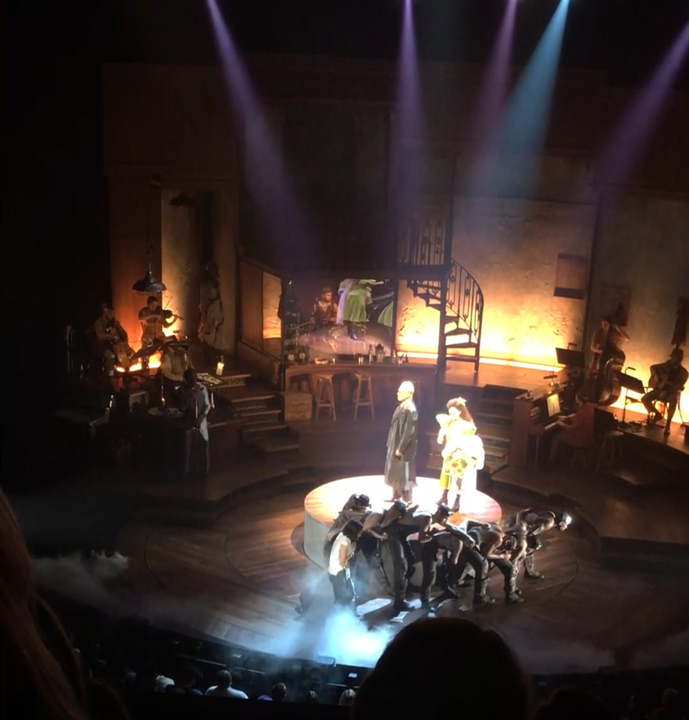
Persephone on how people are starving up above, pointing to Eurydice.
There is another scene where Orpheus figures out that the weather is wack because Hades and Persephone’s love has disappeared and in the elevated center Hades and Persephone recoil from each other as he’s saying that. It’s those moments that really immerse you in what is happening and help convey what is being told more effectively. And more importantly, it is really cool.
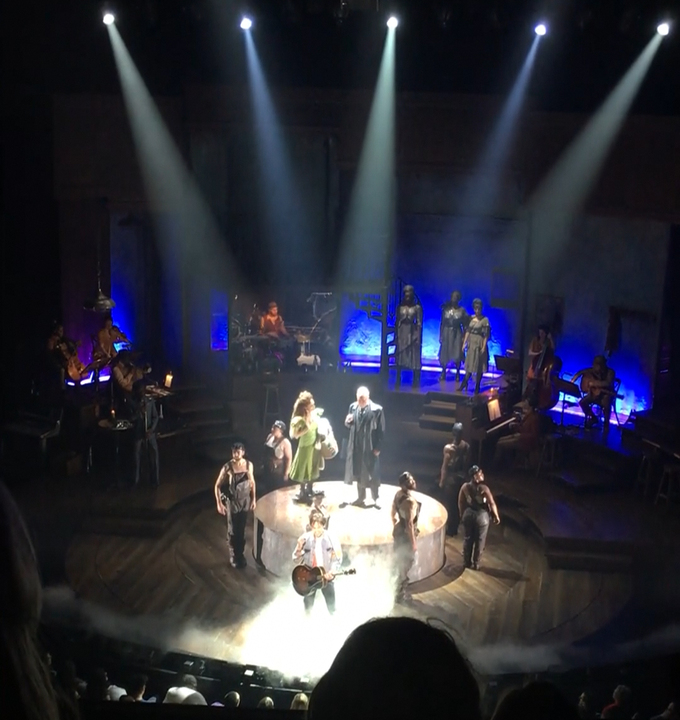
Orpheus saying the gods have forgotten the song of their love as Hades and Persephone recoil from each other.
I think the most important part though is that this setup allows those two things to happen at the same time. The two focuses switching back and forth but on the same stage without any changes in decoration or scenery besides the switch in lighting helps emphasize that parallelism of the relationships that I mentioned above. We see both deteriorating at the same time in real time in the same physical stage. And because of this emphasizing of the parallels, it perfectly sets up for “Epic III” in Act 2.
I Glaze the Triple Turntable
As I mentioned above, this sequence, along with the entire musical, utilizes a triple turntable with the center portion not only able to rotate but to go up and down. I just need to gush about it. The turntable was originally popularized by the original staging of Les Misérables but got a huge boost with Hamilton using a double turntable. Well in this case, it really turns out that more is better with the triple turntable. The rotation really adds a lot of dynamism to the staging and the characters. We can see Orpheus and Eurydice walking during this sequence, which really adds to the struggle they are facing. A lot of the cool things that the triple turntable enables happen in Act 2, but you can still see here how it enhances the staging by allowing characters to actually walk with movement. So, when Eurydice is focused on trying to find food, we can see more clearly the journey and struggle Eurydice is facing.
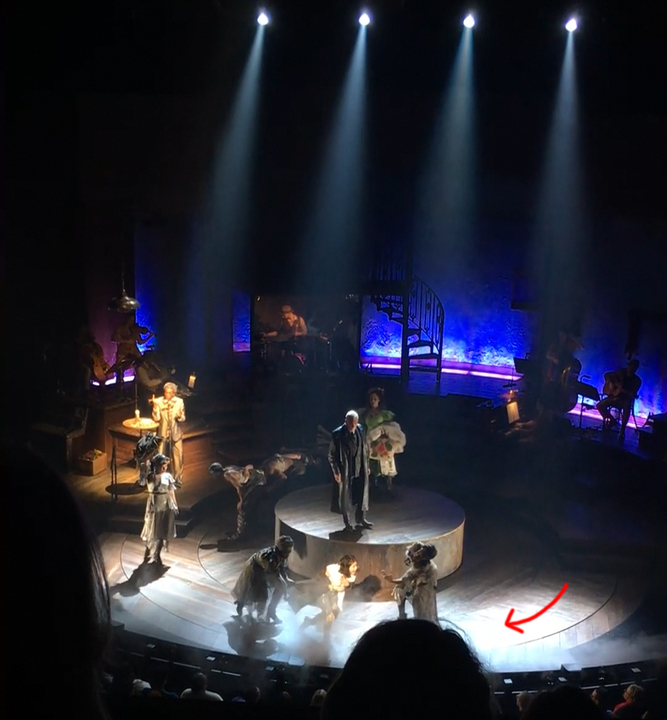
Eurydice struggling against the wind, represented by the Fates. Arrow represent the outer-ring rotation going against the actress’s walking
Also, the center portion that can rise and fall also enhances the staging. In the beginning of this sequence, Hades and Persephone rise up from underground. From that we understand that they are of the underworld and even though they are in the underworld, as gods they are still above the commonfolk, which is represented by the platform literally being above the rest of the people on stage. It’s a really nice touch, which is further enhanced during those moments of slight “interaction”, as if they are “overseeing” us mere mortals. This aspect is also better utilized later on, but I think the sequence is enough to show how good the triple turntable is for the show.
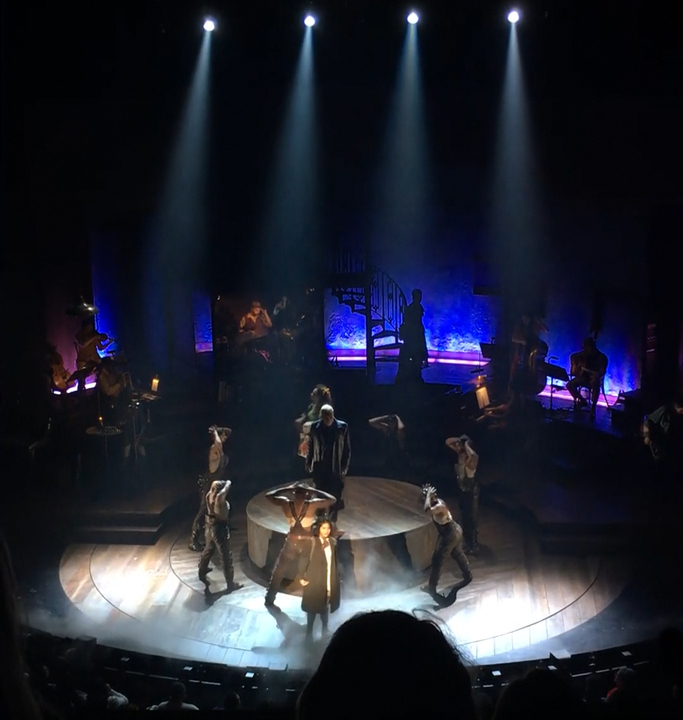
Hades loaming over Eurydice as she struggles against death.
One aspect of the turntable that is really well exemplified during this sequence is how it can imbue the sense of separation between the rings while having them still have a sense of connection due to them being in the same stage. As mentioned above, both the center and outer ring rotate counterclockwise while the ring between them rotates clockwise at the start. The in-between ring is where the workers are, providing physical separation in the form of a human wall while doing their choreography. As it turns out they are slaving away working on a literal wall around Hadestown, so this is really nice foreshadowing. But this separation, the wall between Hadestown and the overworld, is one that gets emphasized with this triple turntable. There is this disruptive ring in-between making that “wall” physically. But they are on the same level as the outer ring, showing that despite being in Hadestown, they are just common people and are still at the mercy of the gods. And the fact that they are in the same stage shows there is connection there.
It All Comes Together
So, with all that setup and the triple turntable, the scene and sequence plays out beautifully. Whenever focus goes back to the overworld, the characters enter from the sides to the outer ring and they do their part. When the focus goes to the underworld, the outer ring clears and the spotlight goes to the center. It makes this switching of focus very natural and not at all abrupt, and this is possible due to the staging allowing it without any scene changes. The rings rotate, providing dynamism to the staging and actors while getting some nice symbolism, and through the light “interactions” we see that things are happening at the same time, emphasizing the parallels there.
All of this I feel is only possible in the medium of theater. The fact that things are happening on the same stage is just something you accept in theater due to the physical constraints of the medium. In a movie, it would be super odd. In a movie, if two groups are in two different locations, they need two different “stages” or scenes. Sure, you can go back and forth between the scenes, but it would be a lot more disruptive than how naturally it occurs here on stage. And it wouldn’t feel as connected to each other than if they were on the same stage, which would reduce the conveying of the parallelism.
Can a Hadestown Movie Work?
So, after watching Wicked, I was thinking about how a Hadestown movie could possibly work, and honestly, I can’t see it. I think for most scenes there are ways that it can translate to the screen. Even that moment in “Wait for Me” (if you know, you know) I can see it possibly being able to be translated. But sequences like “Chant”? I’m sorry but I am very skeptical. I feel like that sequence is something that only works because in theater. It’s perfectly fine to have two scenes in one stage and just pantomime it. And “Chant” I feel is a song that really needs one stage to really work effectively. Like you could do it in a movie, but it would just not be that good in my opinion. I would love to be proven wrong here but for the time being I don’t see it.
Hadestown Was Meant for Theater
Hadestown’s staging is just meant for the stage. It really plays into the strengths of the theater medium, and “Chant” is one of the best showcases of that. It’s not my favorite moment, but the other ones are definitely more spoilery and I feel “Chant” is like the first really cool instance of the type of staging that is so good in Hadestown. It is a production for the theater and is part of the reason why I don’t actually want a move version of Hadestown. Rather I want pro-shot. While it is still not the same as seeing it live, it is a lot closer than what a movie can do and would still allow audiences to experience the staging firsthand.
So yeah, I do know that Broadway is super expensive and inaccessible to a huge majority of people, which I think is really unfortunate and why I hope a pro-shot eventually gets released. I would definitely recommend seeing Hadestown on Broadway if you have the means to be able to. It is my favorite musical and probably my favorite work of art. The staging is absolutely amazing and really makes full use of the theater medium. And I haven’t talked about the themes of the story and all that either. Like I could go on. But I won’t. For now, just know that I absolutely love Hadestown and its staging is a definitely a part of the reason why.
So yeah, that’s the second blog post. This is very different from Fire Emblem, but I do want to talk about things outside Fire Emblem so hopefully you all still enjoyed. This was also another positive-type post; I guess I’m just a positive person. There are some more negative-type posts I want to do, but we’ll cross that road when we get there. Anyways, hope you all enjoyed reading and hope to see you next time!